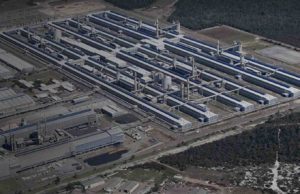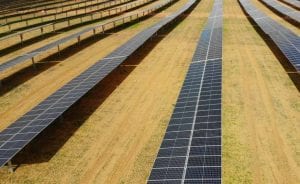A recent New South Wales power supply scare has been found to have been caused – not by renewables – but by a series of gas and coal plant faults and failures that happened to coincide with record high electricity demand as the state sweltered through a February heatwave.
A report published on Wednesday by the Australian Energy Market Operator has found that, like in South Australia, renewable energy performed more or less as expected. But it was the sudden and unannounced failures of gas generators that put power supplies in peril.
The NSW report confirms – as revealed last week by RenewEconomy – that the state narrowly avoided mass blackouts on Friday, February 10, after a faulty gas turbine caused EnergyAustralia’s 480MW Tallawarra gas plant (below) to trip, taking it out of action at around 4.30pm for two hours, just as demand was reaching its peak.

Soon after, Snowy Hydro’s 600MW Colongra gas peaker facility, which had responded to AEMO’s call for supply, informed the market operator that all four of its units had failed to start, due to low gas pressure in the fuel supply line.
Also out of action were two units of the Liddell coal-fired power plant – another 1000MW of thermal generation capacity – that had been closed down the previous Monday due to valve problems.
Solar and wind energy generation were also on the decline, but AEMO insisted that this was in line with what had been forecast, and posed no issues.
Meanwhile, electricity demand in the state was peaking at 14,181MW, just under its February 2011 record of 14,744MW – forcing AEMO to call for Australia’s largest aluminium smelter, Tomago in the hunter Valley, to cut production by nearly 300MW.
This action, and a 200MW reduction in forecast demand that is suspected to have resulted from consumer savings after public pleas from the state government, was all that saved the state from the same sort of rolling blackouts suffered by South Australia in that same week.
“These factors, all coinciding at approximately 5pm combined to overload the NSW interconnections with Queensland and Victoria, creating an insecure operating state,” the AEMO report said.
“With no further generation available to serve the demand and relieve overloading interconnectors, as a last resort at 4.58pm AEMO directed Transgrid to shed the No. 3 hotline at the Tomago aluminium smelter (290MW). … The load was shed by 5.06pm and this action restored the power system to a secure operating state.”
The NSW incident followed rolling blackouts earlier that week in South Australia, as record heat and electricity demand put pressure on the grid.
The SA load-shedding event, which was forecast by AEMO, was swiftly blamed on renewables by the Turnbull government, with federal energy minister fingering the state’s low wind output and “gamble” on renewables.
Prime minister Malcolm Turnbull and others joined in. Later, in question time, Frydenberg blamed the blackout on a “lack of wind”, and Treasurer Scott Morrison, infamously, brandished a lump of coal.
Importantly, AEMO staff told the Senate inquiry into the grid’s resilience that: “Yes, we knew the wind would drop-off and we knew the solar would drop-off at a particular time, but our reserves were fine up until the point when we had forced outages” from gas plants.
The NSW incident, while providing further insight into the challenges facing Australia’s ageing electricity market, highlights a pattern that has been ignored by conservative media and politicians, where major gas and coal plants fail, or go missing, at times of peak demand, or other crises of supply.
In the case of the South Australian outages, 250MW of gas generation capacity at Pelican Point was not switched on, and 120MW of capacity of one of the Torrens Island units – which was running two days earlier – was also idle.
(An AGL spokesperson said the unit was “closed for maintenance”. A Pelican Point release said the unit “was not able to provide a market response under the current rules of the National Electricity Market, (NEM) unless directed by the market operator).”
A further 60MW was lost just before that outage due to gas plants not coping with the heat, while another 65MW was lost when the Port Lincoln gas plant packed it in.
350.org said today that AEMO’s latest report was a wake up call for the Turnbull government to stop it’s “ideological anti-renewable crusade” and focus on transitioning Australia’s ageing coal and gas infrastructure to clean energy.
“Malcolm Turnbull was so keen to use the South Australian blackout as an excuse to hit renewables – even though he was given evidence to show renewables played no part – but is silent on the danger ageing coal and gas plants pose to grid security,” 350.org energy spokesperson, Josh Creaser said.
“The saddest part for Malcolm Turnbull’s is that recent polling shows his desperate attempt at a scare campaign on energy security has failed dismally, with two-thirds of Australians supportive of more renewable energy.
“It is also up to AGL and EnergyAustralia to speed up the closure of these dirty power stations in line with climate science,” Creaser said.
“Climate change is only going to lead to more extreme weather events like the NSW heatwave, which will further put stresses on ageing coal and gas infrastructure. Many of these plants are already existing beyond their lifespan and are a liability to the grid and the climate.”








